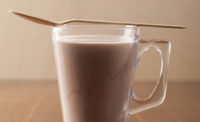Dairy may be an ideal vehicle for creating value-added products because it already contains a number of beneficial nutrients and is an excellent or good source of nine essential nutrients (calcium; potassium; phosphorus; protein; vitamins A, B12 and D; riboflavin; and niacin).
According to the International Food Information Council Foundation 2008 Survey on Consumer Attitudes toward Food, Nutrition and Health, 80% of Americans consume, or are interested in consuming, foods and beverages with specific health benefits. Of the specific health benefits addressed in the IFIC survey, Americans most likely believed that foods and beverages could improve heart health, physical energy, stamina and digestive health, and help maintain overall health and wellness.
The dairy industry has made great strides to respond to consumers’ interests in value-added products by enhancing dairy’s naturally existing healthful attributes with several different ingredients. Plant sterols and stanols, omega-3 fatty acids and probiotics are among several value-added ingredients that have been added to dairy products.
Plant sterols and stanols
Scientific studies demonstrate that plant sterols and stanols may be effective in reducing coronary heart disease risk by reducing plasma low-density lipoprotein, or LDL (bad cholesterol). The Food and Drug Administration determined there is sufficient data supporting the safety and cholesterol lowering effects of plant sterol/stanol esters. The FDA authorized a health claim for reducing the risk of coronary heart disease for foods with these substances. The agency concluded that “1.3 grams per day of plant sterol esters or 3.4 grams per day of plant stanol esters in the diet are needed to show a significant cholesterol lowering effect. In order to qualify for this health claim, a food must contain at least 0.65 grams of plant sterol esters per serving or at least 1.7 grams of plant stanol esters per serving. The claim must specify that the daily dietary intake of plant sterol esters or plant stanol esters should be consumed in two servings eaten at different times of the day with other foods” (www.cfsan.fda.gov/~dms/lab-ssa.html).
To qualify, the food must also be low in saturated fat and cholesterol, and meet other qualifying criteria. This claim can be used on qualifying products such as fat-free milk with the appropriate levels of plant sterols or stanols.
In 2008, AbuMweis and colleagues published the results of a meta-analysis of 59 studies with plant sterols or stanols. They reported that the amount of reduction in plasma LDL levels from the intake of plant sterol/stanol-containing-products depends on whether a person had normal or elevated plasma LDL levels (a greater reduction in LDL was observed in those with elevated LDL levels) and the frequency and time of intake. Moreover, they reported that certain foods may be better vehicles to deliver the plant sterol/stanol health benefits. Specifically, they found a greater reduction in LDL when plant sterols/stanols were incorporated into fat spreads, mayonnaise and salad dressing, or milk and yogurt compared with other food products such as croissants and muffins, orange juice, non-fat beverages, cereal bars and chocolate. Similarly, Clifton et al. (2004) reported that plant sterol esters in low-fat milk were almost three times more effective than in bread and cereal in lowering plasma cholesterol levels.
According to Euromonitor Inter-national, new products with plant sterols are a key growth area in the United States. With dairy products dominating the cholesterol-lowering food category in Europe (greater than 120 cholesterol-lowering dairy products currently introduced in the market place) and the United States (greater than 20 cholesterol-lowering dairy products currently in the market place), the dairy industry has the opportunity to continue developing value-added dairy products to meet consumer demand.
Omega-3/DHA/EPA
Omega-3 polyunsaturated-fatty acids, such as alpha linolenic acid, eicosapentaenoic acid (EPA) and docosahexaenoic acid (DHA) also have been added to milk, cheese and yogurts. The FDA has authorized a qualified health claim for DHA and EPA omega-3 fatty acids and reduced risk of heart disease. The FDA determined “supportive, but not conclusive research shows that consumption of EPA and DHA omega-3 fatty acids may reduce the risk of coronary heart disease” (www.cfsan.fda.gov/~dms/ds-ltr37.html).
As for all health claims, the food must be low in saturated fat and cholesterol and meet other qualifying criteria as specified by FDA. Dairy foods with omega-3 fatty acids also may utilize structure/function claims that describe the role of the omega-3 fatty acids on normal functions. The American Heart Association recommends 1 gram of DHA plus EPA for adults with coronary heart disease and 2 to 4 grams a day for patients who need to lower triglyceride levels.
Dairy products with EPA or DHA omega-3s can be one way for people to increase their intake of these fatty acids, along with the intake of fatty fish. DHA omega-3 also plays a role in brain development and function, as well as normal eye function. Omega-3s provide an opportunity for the dairy industry to expand upon the benefit claims for dairy products.
Dairy products with omega-3 fatty acids include Kemp’s Plus Healthy Lifestyle 1% milk, with EPA/DHA omega-3s and increased calcium, and Cabot cheddar cheese with omega-3 DHA and half of the fat of regular cheddar cheese.
Probiotics
Probiotics are marketed as promoting digestive health and “helping to strengthen your body’s defenses.” With no regulatory definition of probiotics, the WHO/FAO definition – “live microorganisms, which when administered in adequate amounts, confer a health benefit on the host” – is the most widely accepted definition of a probiotic. Accordingly, to be considered a probiotic, a health benefit to humans – such as improved intestinal transit, lactose digestion and immune function – should be shown when the probiotic is consumed.
When probiotics are added to a food, they must first survive food processing, storage and ultimately the human gastrointestinal tract. Dairy may be an optimal delivery vehicle for probiotics. First, the cold storage of dairy foods may help promote the stability of the probiotic. Second, dairy foods may help buffer the probiotic from stomach acid. Third, the naturally nutrient rich package of many dairy foods further support growth of the organism, as well as providing many health benefits for the consumer.
Although the research in this field is expanding, there is a lot more we need to learn about these “healthy bugs.” There are thousands of different strains of probiotics and researchers are currently investigating specific health-related benefits for many of these different strains. Since the specific benefits of probiotics are dependent on the strain, species, genera and amount of the microorganism, general statements about the benefits of probiotics are limited. At this time, there are no FDA-preapproved claims for probiotics.
Dairy is the market leader of probiotic value-added products, with $182 million in U.S. market sales of probiotic spoonable yogurt between 2001 and 2006, according to Euromonitor International. Products with probiotics include Dannon’s Activia and General Mills’ Yo-Plus.
Many opportunities exist for expanding the dairy case to meet consumer demand for products with added health benefits that may help improve public health. The use of plant sterols/stanols, omega-3 fatty acids and probiotics are only a few examples of current and future opportunities for developing value-added dairy products.
Other product development opportunities for the dairy industries include use of fiber, whey protein and vitamin D (cheese and yogurt). In 2008, cis-9, trans-11 conjugated linoleic acid (CLA) and trans-10, cis-12 CLA supplements achieved FDA GRAS status and may now be added to dairy products. The potential opportunities for the addition of CLA to dairy products need to be fully evaluated.
With dairy containing many beneficial nutrients, the dairy industry has the opportunity to not only help consumers meet the daily recommended three servings of low-fat and fat-free milk and milk products, but also provide value-added dairy products to help meet consumer demand.
Contributed by Susan Zaripheh, Ph.D., and Gregory Miller, Ph.D., MACN, who are nutritional professionals with the National Dairy Council/Dairy Management Inc.

